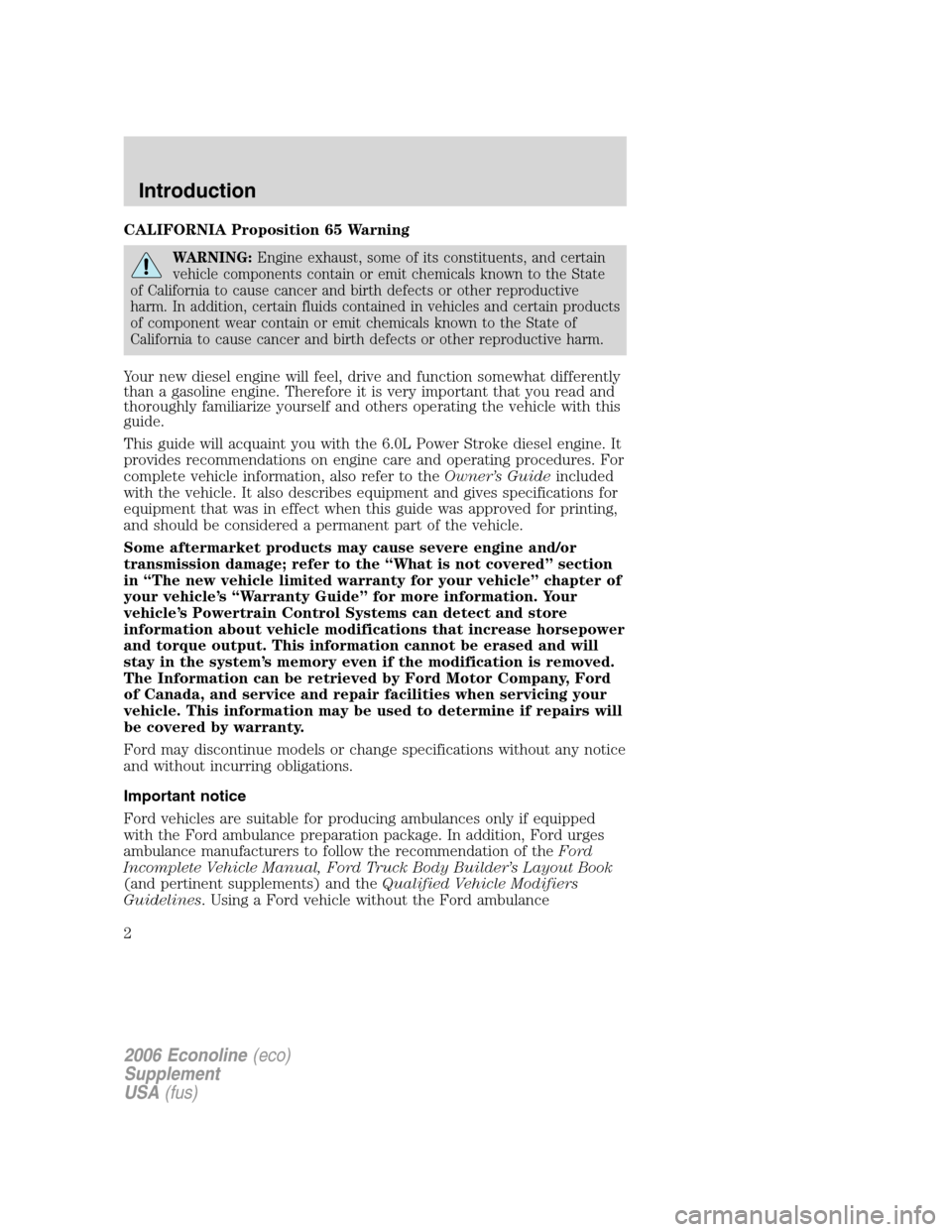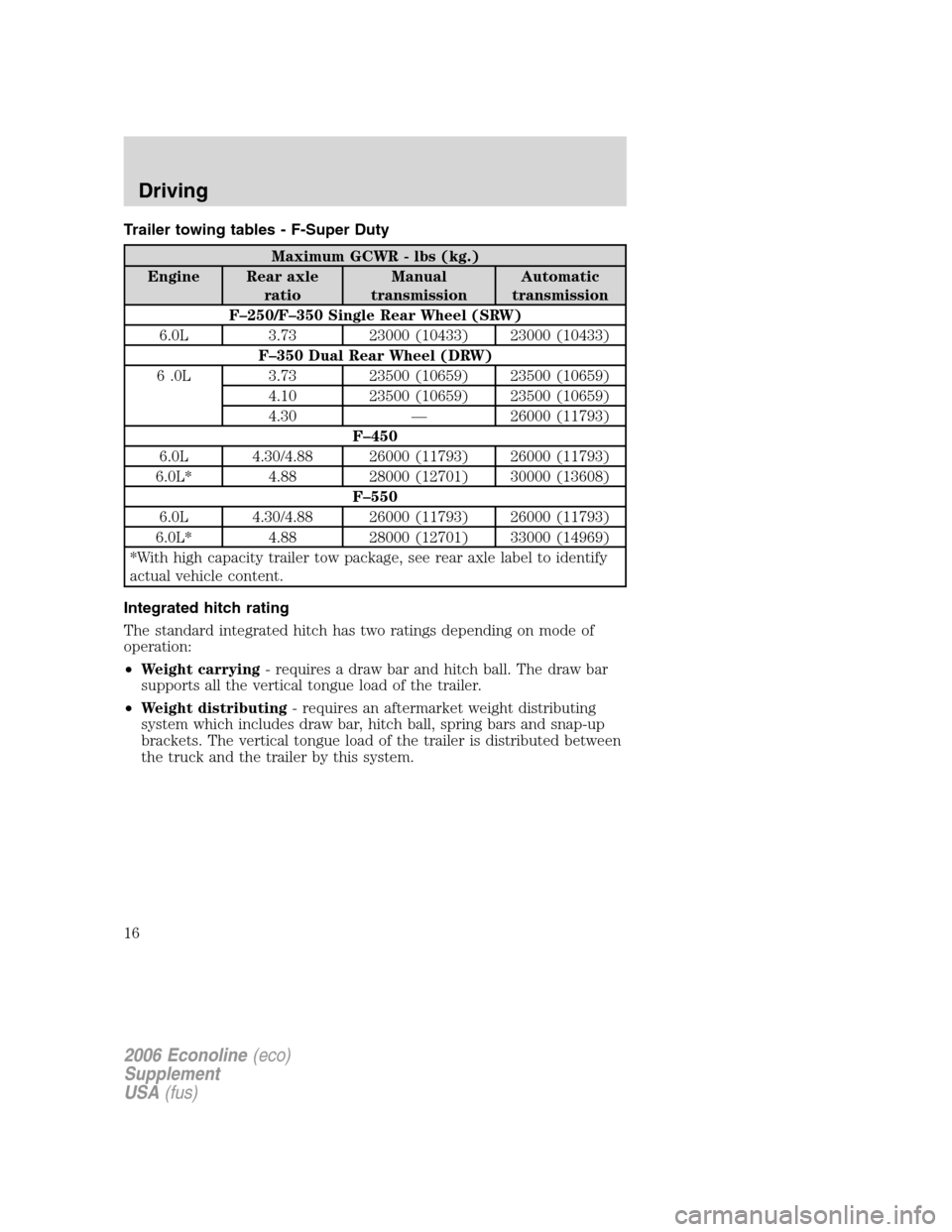Page 2 of 72

CALIFORNIA Proposition 65 Warning
WARNING:Engine exhaust, some of its constituents, and certain
vehicle components contain or emit chemicals known to the State
of California to cause cancer and birth defects or other reproductive
harm. In addition, certain fluids contained in vehicles and certain products
of component wear contain or emit chemicals known to the State of
California to cause cancer and birth defects or other reproductive harm.
Your new diesel engine will feel, drive and function somewhat differently
than a gasoline engine. Therefore it is very important that you read and
thoroughly familiarize yourself and others operating the vehicle with this
guide.
This guide will acquaint you with the 6.0L Power Stroke diesel engine. It
provides recommendations on engine care and operating procedures. For
complete vehicle information, also refer to the Owner’s Guideincluded
with the vehicle. It also describes equipment and gives specifications for
equipment that was in effect when this guide was approved for printing,
and should be considered a permanent part of the vehicle.
Some aftermarket products may cause severe engine and/or
transmission damage; refer to the “What is not covered” section
in “The new vehicle limited warranty for your vehicle” chapter of
your vehicle’s “Warranty Guide” for more information. Your
vehicle’s Powertrain Control Systems can detect and store
information about vehicle modifications that increase horsepower
and torque output. This information cannot be erased and will
stay in the system’s memory even if the modification is removed.
The Information can be retrieved by Ford Motor Company, Ford
of Canada, and service and repair facilities when servicing your
vehicle. This information may be used to determine if repairs will
be covered by warranty.
Ford may discontinue models or change specifications without any notice
and without incurring obligations.
Important notice
Ford vehicles are suitable for producing ambulances only if equipped
with the Ford ambulance preparation package. In addition, Ford urges
ambulance manufacturers to follow the recommendation of the Ford
Incomplete Vehicle Manual, Ford Truck Body Builder’s Layout Book
(and pertinent supplements) and the Qualified Vehicle Modifiers
Guidelines . Using a Ford vehicle without the Ford ambulance
2006 Econoline (eco)
Supplement
USA (fus)
Introduction
2
Page 16 of 72

Trailer towing tables - F-Super Duty
Maximum GCWR - lbs (kg.)
Engine Rear axle
ratioManual
transmissionAutomatic
transmission
F–250/F–350 Single Rear Wheel (SRW)
6.0L 3.73 23000 (10433) 23000 (10433)
F–350 Dual Rear Wheel (DRW)
6 .0L 3.73 23500 (10659) 23500 (10659)
4.10 23500 (10659) 23500 (10659)
4.30 — 26000 (11793)
F–450
6.0L 4.30/4.88 26000 (11793) 26000 (11793)
6.0L* 4.88 28000 (12701) 30000 (13608)
F–550
6.0L 4.30/4.88 26000 (11793) 26000 (11793)
6.0L* 4.88 28000 (12701) 33000 (14969)
*With high capacity trailer tow package, see rear axle label to identify
actual vehicle content.
Integrated hitch rating
The standard integrated hitch has two ratings depending on mode of
operation:
•Weight carrying- requires a draw bar and hitch ball. The draw bar
supports all the vertical tongue load of the trailer.
•Weight distributing- requires an aftermarket weight distributing
system which includes draw bar, hitch ball, spring bars and snap-up
brackets. The vertical tongue load of the trailer is distributed between
the truck and the trailer by this system.
2006 Econoline(eco)
Supplement
USA(fus)
Driving
16
Page 21 of 72
4. Make the final connection of the negative (-) cable to an exposed
metal part of the disabled vehicle’s frame or chassis, away from the
batteries.Do notuse fuel lines, brake lines, exhaust components or the
battery trays asgroundingpoints.
Do not connect the end of the second cable to the negative (-)
terminal of the battery to be jumped. A spark may cause an
explosion of the gases that surround the battery.
5. Ensure that the cables are clear of moving parts or any fuel delivery
system, brake system or exhaust system parts.
Jump starting
1. Start the engine of the booster vehicle and run the engine at
moderately increased speed.
2. Start the engine of the disabled vehicle.
3. Once the disabled vehicle has been started, run both engines for an
additional three minutes before disconnecting the jumper cables.
2006 Econoline(eco)
Supplement
USA(fus)
Roadside emergencies
21